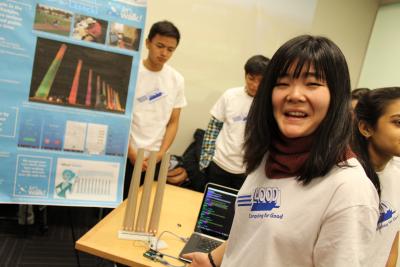Students apply computing skills to social causes in new course

Tiny lights flashed beside a cardboard replica of the Waterfront smokestacks as a new special topics course wrapped up the semester with final project demos in the Kiesler-Kraut Commons lobby of Newell-Simon Hall on Thursday, December 7.
The new Carnegie Mellon University human-computer interaction course, taught by Afsaneh Doryab and Anind Dey, explored how computing skills can be applied to social and global causes.
Students were divided into groups and assigned to one of seven causes. In the course of one semester, the undergraduate and graduate students from a variety of majors were able to see the positive impact of their work.
Project sponsors were located as close by as West Homestead but in a few cases as far away as Africa.
One student attended the class remotely from CMU Africa, and joined the demo day presentations from Rwanda via Skype. This distributed team of two -- one from a laptop sitting on a table and one local teammate -- explained their solution to use augmented reality (AR) to assist farmers with the adoption of irrigation technology in Africa. This was the students’ first AR project, and they were excited to try out the features that came out with the latest iOS update in September.
Another team learned about the health risks associated with a sedentary lifestyle and was tasked with increasing the physical activity level in the citizens of the West Homestead neighborhood of Pittsburgh.
Even though their team didn’t have any computer science majors, they still were able to create a high-fidelity prototype of a community step-counting app called “Let’s Walk!” during the class.
The concept is that the app counts the steps of participating walkers nearby. Once a certain number of collective steps has been achieved each day, the area unlocks a reward.
The benefits of a diverse group of students working together were evident by the creativity of their ideas. For example, this team’s solution encouraged physical activity by including the gamification of walking, rewards for completing the task (a light show display on the smokestacks and discounts to redeem in local businesses), and the encouragement that comes from working towards a collective goal.
Doryab was pleased with her students’ work. “I believe that when students work on solutions that have social and global impact they become more motivated and committed to the work. As a result, they learn faster and deeper and produce better outcomes. During the semester, students not only designed complete and innovative solutions but also developed fully functional prototypes of their design, which they demoed on the final day. Their clients frequently mentioned that the outcome of projects exceeded their expectations.”
Other project topics included:
- Protecting wildlife in the DR Congo by applying deep learning to identify illegal mining sites
- Helping farmers in India to predict crop yields and achieve financial stability
- Matching in-need populations with online education
- Enabling high-throughput catalyst design for renewable energy
- Sustainably reducing post-harvest loss in the developing world with the help of an app
Throughout the course of the semester, students also enjoyed guest lectures from faculty in other areas of HCI, Computer Science, and Engineering. Lectures included relevant topics like implicit bias, machine learning, ubiquitous and mobile computing, data visualization and crowdsourcing.
All of the students were wearing the same white t-shirt for the demonstrations, which was designed by one of the students in the class. On the front, “Computing for Good,” was written in blue (the color of technology) on a transistor as a symbol for computing. On the back was the quote “Be the change you want to see in the world,” by Mahatma Gandhi.
The course projects will continue as independent group studies in the spring to give students opportunities to advance and deploy their solutions, and the course, 05-499 / 05-899, will be taught again in fall 2018.

